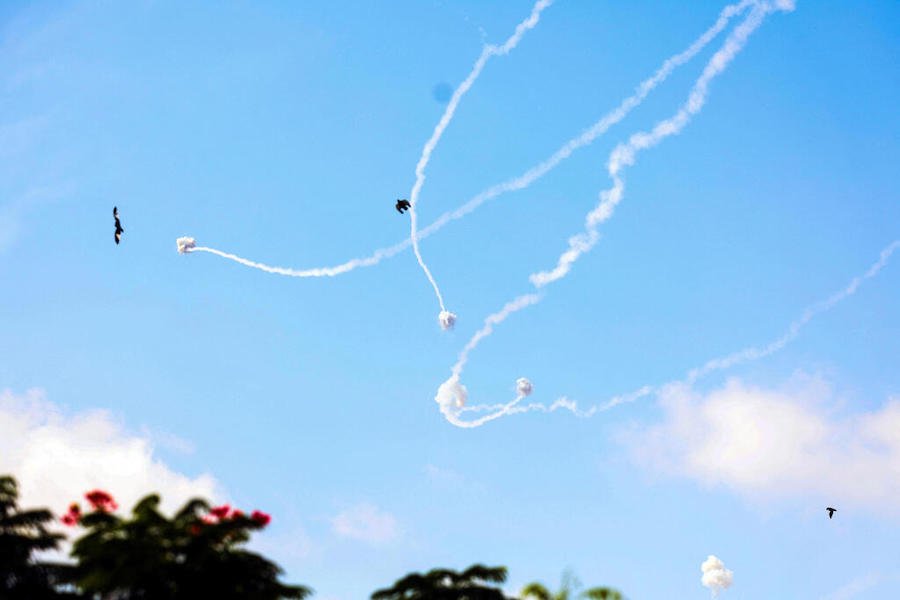How tech led the IDF to lose touch with reality and fail to thwart Hamas

Shielded by the seductive protection of the Iron Dome, the IDF was drawn into a pattern of merely "containing" rocket attacks from Gaza, while the political leadership pursued a policy of harmful neglect
About a year after the end of the Second Lebanon War, a discussion was held in Israel which focused on the integration of advanced technological solutions on the battlefield. In the background, there was intense public criticism of the IDF's inadequate preparedness during the 2006 war, its disappointing performance on the battlefield, and the emergence of a troubling phenomenon: commanders and senior officers were often found behind plasma screens and in armored personnel carriers, rather than on the frontlines with their soldiers.
During this period, senior officers both past and present engaged in extensive discussions about the future battlefield. Topics ranged from the potential of drones to handle various tasks, the importance of commanders being in positions that allow them to have the greatest influence on the battle, the significance of technological superiority over the enemy, and the definitions of victory in battle and the decision-making process. It was during one of these discussions that Major General (ret.) Yanush Ben-Gal, an expert in combat simulation, made a memorable point about the IDF's growing reliance on technology and "bionic soldiers."
His remarks had a semi-theatrical quality, suggesting his deep concern over the IDF's increasing dependence on buttons and screens. "How can a soldier effectively engage with so many devices?" he asked. "With antennas on their heads, night and day vision, and a constant stream of information from various sources, it's as if we expect them to process all this data while they are under fire."
He continued, "Despite all these advancements, If I'm just a regular soldier being shot at, I would toss all of it aside, grab my weapon, and fight for what's right."
Although the audience reacted with laughter, Ben-Gal's message was serious. Those who had been with him in the Golan Heights during the Yom Kippur War understood what he meant. While button wars might be suitable for computer games, in real life, understanding the terrain and engaging with the enemy required being physically present.
Ben-Gal's words were soon forgotten, he passed away in 2016 at the age of 79, and others began to express new perspectives. The IDF, in the meantime, became heavily focused on modernizing and closing the substantial gaps revealed during past conflicts. Defense industries worked tirelessly to develop advanced command and control systems, remotely controlled firing positions, real-time camera arrays, and drones of all sizes capable of various missions.
The generational shift among the IDF's leadership gradually reduced conservatism, and the army began to embrace technology more comprehensively. The Israeli Air Force had been a pioneer in the field, especially in unmanned aircraft operations. The success of the Iron Dome, starting with its first operational interception in 2011, had a powerful impact. However, this success had unintended consequences.
While the Iron Dome provided critical security, it also enabled the political leadership, led by Prime Minister Benjamin Netanyahu for much of that time, to delay making a cohesive policy for Gaza. Instead of seeking long-term agreements and maintaining a stable status quo in the south and the surrounding settlements, they relied on the Iron Dome to mitigate the immediate threats from Gaza.
When Hamas realized that its rocket attacks had lost much of their deterrence, they invested in a network of cross-border attack tunnels from the Gaza Strip into Israeli territory. The exposure of these tunnels, especially during Operation Protective Edge in 2014, thwarted a major terror attack.
Building on the success of the Iron Dome, the security establishment collaborated with Rafael and Elbit Systems to create a new form of defense: an "underground Iron Dome." This system comprised a massive concrete wall dug deep into the ground, equipped with sensors to detect tunnel digging in real time.
Scenarios of armed assaults on the border involving anti-tank missiles led to the development of advanced technologies capable of withstanding the most challenging operational conditions. This transformation was further supplemented with the deployment of dense networks of cameras along the border.
These cameras provided real-time surveillance, day and night, under all weather conditions. This visual feed was transmitted directly to highly skilled female observers. When necessary, they could raise red flags, coordinate rapid response and intervention forces, and direct precision fire at any approaching threats.
This massive technological overhaul bought the IDF and the political leadership several years of relative peace. The need for a comprehensive and sustainable approach to the Gaza issue was suppressed, leading to a lack of resolution.
However, the enemy was not idle. Hamas sought to enhance its capabilities and resources. Then came the fateful day last Saturday when the border's defenses were breached. Hundreds of terrorists launched a brutal assault, and the IDF was unprepared.
In hindsight, it's evident that there was arrogance in underestimating Hamas's ability to adapt to Israeli strategies and identify weaknesses in the defense system. The result was a catastrophic failure during the recent events in Gaza, where hundreds of terrorists wreaked havoc while the IDF was blind, deaf, and unresponsive for hours.
This situation raises the question of how different things might have been if, on that fateful morning, someone had simply raised a pair of binoculars toward Gaza. These would be plain binoculars, not connected to satellites or complex systems, but a simple tool requiring human eyes and judgment. Perhaps this simple action could have led to a different outcome, one that didn't result in a catastrophic disaster of biblical proportions.
Related News
